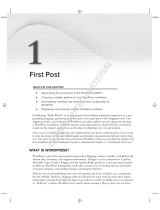
878
Choosing a Web Host
✦ The firewall is the first line of defense. If your firewall blocks external
access to your servers, the only real danger your system faces is from
yourself. Begin with a solid firewall and ensure that you don’t allow
access to port 80 (Apache) or port 3306 (MySQL) unless you’re abso-
lutely sure that you have the appropriate security measures in place.
✦ I left phpMyAdmin open. phpMyAdmin needs root access to the
MySQL database, so if anybody can get to phpMyAdmin through the
Web server, they can get to my data and do anything to it. Because my
firewall is blocking port 80 access, you can’t get to phpMyAdmin from
anything other than localhost access, and it’s not really a problem.
✦ I’m not running a mail or FTP server on this machine. The security
system isn’t sure whether my FTP or mail system is secure, but because
I’m not running them, it isn’t really a problem.
Choosing a Web Host
Creating a local server is useful for development purposes because you can
test your programs on a server you control, and you don’t need a live con-
nection to the Internet.
However, you should avoid running a production server on your own computer,
if you can. A typical home connection doesn’t have the guaranteed IP number
you need. Besides, you probably signed an agreement with your broadband pro-
vider that you won’t run a public Web server from your account.
This situation isn’t really a problem, because thousands of Web hosting ser-
vices are available that let you easily host your files. You should consider an
external Web host for these reasons:
✦ The host, not you, handles the security headaches. This reason alone
is sufficient. Security isn’t difficult, but it’s a never-ending problem
(because the bad guys keep finding new loopholes).
✦ The remote server is always up. Or, at least, it should be. The dedicated
Web server isn’t doing anything other than serving Web pages. Your
Web pages are available, even if your computer is turned off or doing
something else.
✦ A dedicated server has a permanent IP address. Unlike most home con-
nections, a dedicated server has an IP address permanently assigned to
it. You can easily connect a domain name to a permanent server so that
users can easily connect.
✦ Ancillary services usually exist. Many remote hosting services offer
other services, like databases, FTP, and e-mail hosting.
✦ The price can be quite reasonable. Hosting is a competitive market,
which means that some good deals are available. Decent hosting is avail-
able for free, and improved services are extremely reasonable.
53_9780470537558-bk08ch01.indd 87853_9780470537558-bk08ch01.indd 878 10/7/10 8:58 PM10/7/10 8:58 PM

























